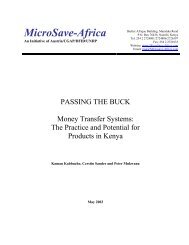Create successful ePaper yourself
Turn your PDF publications into a flip-book with our unique Google optimized e-Paper software.
Photo source: Wikimedia Commons<br />
Sticking to the Straight and Narrow<br />
In the 1970s, doing business—whether commerce or development—with<br />
foreign clients had long involved a variety <strong>of</strong><br />
customary, but unsavory, transactions. USAID, in fact, was<br />
the only international development donor that made a serious<br />
effort to eradicate such problems—typically characterized<br />
by government <strong>of</strong>ficials and other influentials skimming<br />
development funds through “paper” local firms, padded<br />
expenses, or consulting deals. In 1977, in response to some<br />
high-pr<strong>of</strong>ile cases <strong>of</strong> this kind in the private sector, Congress<br />
passed the Foreign Corrupt Practices Act.<br />
Mickelwait and Barclay went to see a lawyer for a primer on<br />
the new law. The odds <strong>of</strong> getting caught are low, the lawyer<br />
advised, but “the odds <strong>of</strong> going to jail if you’re caught are<br />
very high,” he cautioned. “It’s called a felony.” That resolved<br />
the problem. Henceforth, Mickelwait and Barclay kept an<br />
eye out for international funding but resolved never to sign a<br />
contract at the cost <strong>of</strong> corruption.<br />
20<br />
The breakneck growth <strong>of</strong> the late 1970s created some less<br />
visible but serious cultural challenges. One was a perceived<br />
disconnect between the ideals <strong>of</strong> development and the<br />
imperatives <strong>of</strong> running a business. As late as the 1970s, said<br />
Gary Kilmer, who joined <strong>DAI</strong> in 1980, most development<br />
practitioners with academic backgrounds were deeply skeptical<br />
<strong>of</strong> business, and viewed pr<strong>of</strong>it as nothing more than a<br />
“necessary evil.” Even among <strong>DAI</strong>’s home <strong>of</strong>fice staff, several<br />
<strong>of</strong> whom had begun buying stock in the late 1970s, there was<br />
a sense, perhaps best expressed by Craig Olson, that doing<br />
development and running a business posed a fundamental<br />
conflict. “Are we a development company or are we a pr<strong>of</strong>itmaking<br />
company?” he asked. At the time, Olson recalled,<br />
“there was also no little bit <strong>of</strong> anxiety because as you grow<br />
larger, you inevitably go from informality to more formality and<br />
from no rules to some rules.”<br />
By 1980, most <strong>of</strong> <strong>DAI</strong>’s development pr<strong>of</strong>essionals had been<br />
convinced that the firm could prosper without losing its “development<br />
ethic,” and if a hint <strong>of</strong> ambivalence remained with<br />
some, it was evident to most that a pr<strong>of</strong>itable company could<br />
afford to do more <strong>of</strong> the development work that the founders<br />
and the staff so fervently believed in, and do it better. Seen in<br />
that light, the company’s performance in fiscal 1980 seemed<br />
to point the way toward a bright future. In that year alone,<br />
<strong>DAI</strong>’s revenues more than tripled from just under $2 million to<br />
$6.5 million. The number <strong>of</strong> personnel tripled over the same<br />
period, while pr<strong>of</strong>its grew from $77,000 to $202,000. Most important,<br />
the people <strong>of</strong> <strong>DAI</strong> could see with their own eyes that<br />
the projects they were implementing were beginning to make<br />
a real difference, in Sudan, Indonesia, Zaire, and elsewhere.<br />
It was a heady time, then, when in late July 1980, just a<br />
few weeks after the close <strong>of</strong> what everyone believed to be<br />
a remarkable fiscal year, <strong>DAI</strong>’s managers and their families



